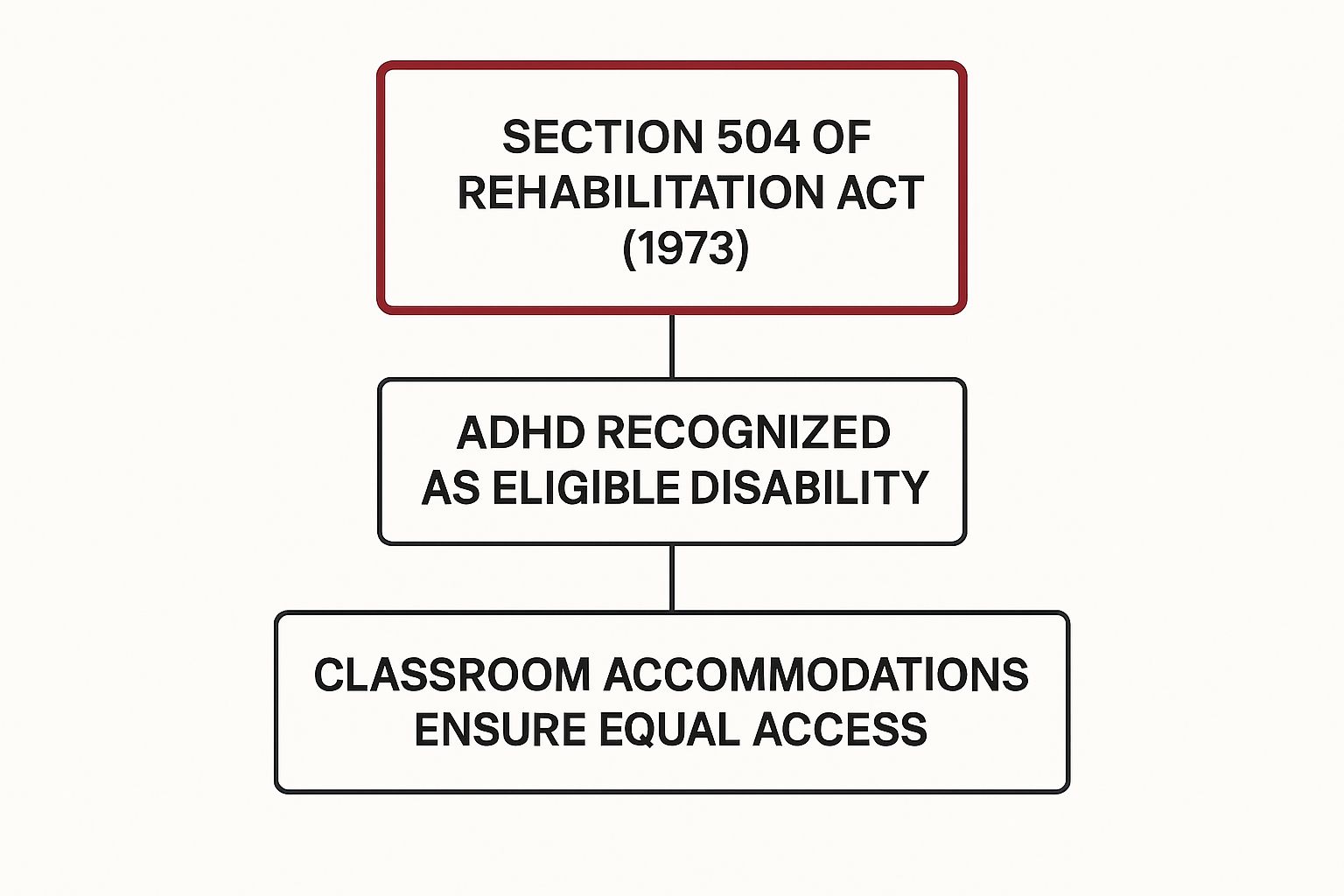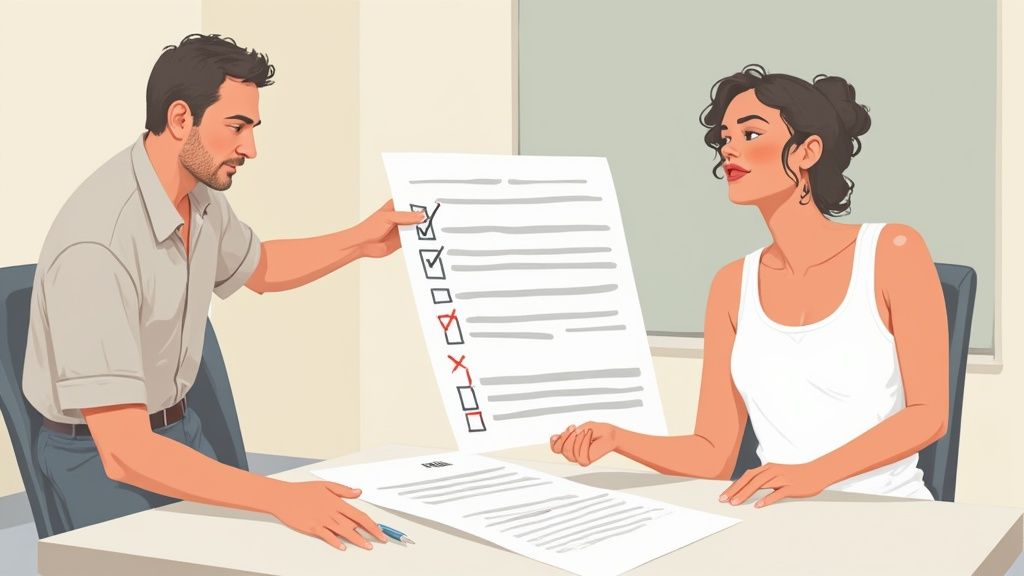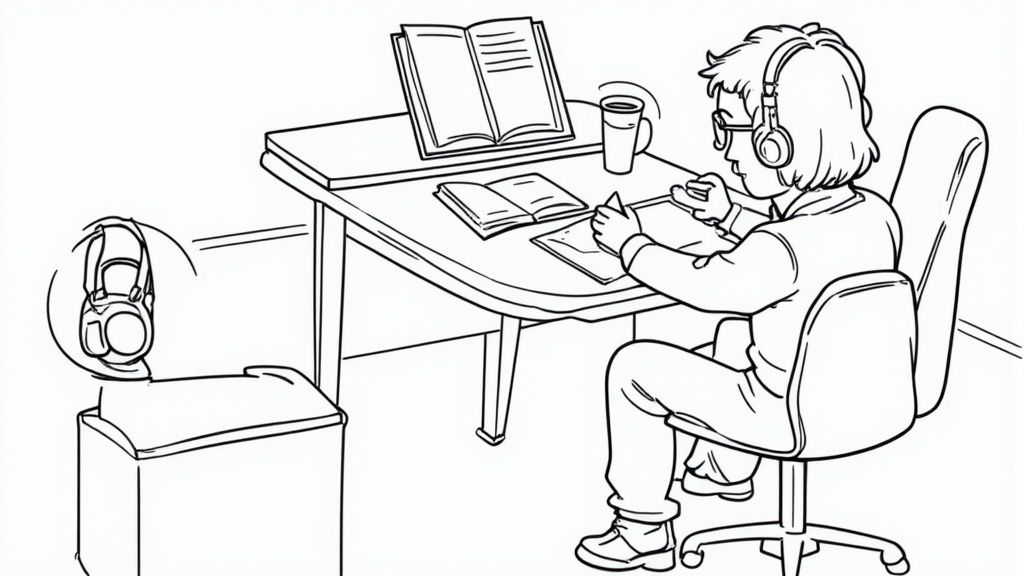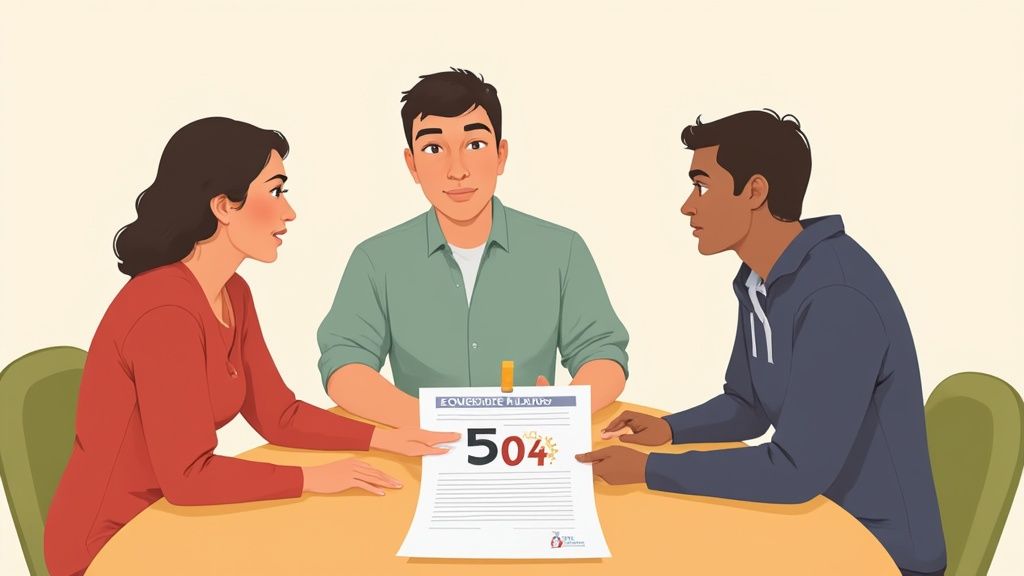A 504 plan for ADHD is a formal, written plan that schools put together to give kids with disabilities the support they need to learn right alongside their peers. You can think of it as a blueprint for removing barriers in the classroom, ensuring a child with ADHD has the same shot at success as any other student.
What Is a 504 Plan for ADHD
Instead of seeing a 504 plan as some complicated legal document, think of it as a bridge to success for your child. It’s a practical, straightforward plan designed to give them fair access to learning in a general education classroom.
Here’s an analogy I like to use: imagine a building with a set of stairs at the entrance. For most people, those stairs are no big deal. But for someone in a wheelchair, they're a huge barrier. A ramp doesn’t change the building's purpose; it just provides equal access. A 504 plan for ADHD works the exact same way—it provides accommodations that act as a ramp to their education.
The Legal Foundation
This plan gets its name from Section 504 of the Rehabilitation Act of 1973, which is a federal civil rights law. This law is pretty clear: it prohibits disability discrimination by any program or activity that gets federal funding, and that includes public schools.
Under Section 504, ADHD is recognized as a potential disability if it substantially limits one or more major life activities—things like concentrating, thinking, or learning. Understanding your child's rights under Section 504 is really the first step toward becoming their best advocate.
This infographic breaks down how that foundational law translates into real, practical support in the classroom.
As you can see, there’s a clear path from a major civil rights law to tangible help for your child. It’s all about ensuring they have equal access to their education.
Is a 504 Plan the Same as an IEP
This is a common point of confusion, so let's clear it up. A 504 plan is not the same as an Individualized Education Program (IEP). They're both designed to help students, but they come from different laws and serve different purposes.
The easiest way I've found to explain the difference is 'access' versus 'instruction.' A 504 plan ensures your child has equal access to the general education environment through accommodations. An IEP, on the other hand, is for students who need specialized instruction and services to make academic progress.
An IEP actually changes the educational program itself. A 504 plan focuses on leveling the playing field within the existing program. Many kids with ADHD do incredibly well with the support of a 504 plan. In fact, research shows about 13.6% of children with ADHD have a 504 plan, while a larger group needs the more intensive support of an IEP.
Here’s a quick comparison to help you see the differences at a glance.
504 Plan vs IEP at a Glance
| Feature | 504 Plan | IEP (Individualized Education Program) |
|---|---|---|
| Governing Law | Section 504 of the Rehabilitation Act of 1973 (a civil rights law) | Individuals with Disabilities Education Act (IDEA) (an education law) |
| Primary Purpose | Provides access to the general education curriculum through accommodations. | Provides specialized instruction and related services. |
| Who is Eligible? | Students with a disability that substantially limits a major life activity. | Students with one of 13 specific disabilities who need special education. |
| What It Does | Levels the playing field in the general education classroom. | Changes the educational program to meet the student's unique needs. |
| Written Document | A formal plan outlining accommodations. | A detailed, legally binding document outlining goals, services, and progress tracking. |
While they might seem similar, understanding these key distinctions is crucial when you're advocating for the right kind of support for your child.
How Your Child Becomes Eligible for a 504 Plan
Navigating the eligibility process for a 504 plan for ADHD can feel a bit like learning a new language. But it really boils down to two key questions. First, does your child have a physical or mental impairment (like ADHD)? Second, does that impairment substantially limit one or more major life activities?
That term, "major life activities," is broader than you might think. It covers the obvious academic stuff—reading, concentrating, thinking—but it also includes things like communicating, interacting with others, and managing their own behavior.
It’s a common myth that a child needs to be failing to qualify. A student who has to work twice as hard as their peers just to pull a "B" or who feels a huge amount of stress to keep up in class could absolutely be considered "substantially limited." The focus isn't just on the grade; it's on the effort and struggle behind it.
Kicking Off the Evaluation Process
The first real step toward getting a 504 plan is making a formal, written request for an evaluation. Think of this as your official starting gun in advocating for your child.
And it doesn't always have to be a parent who starts the process. While it usually is, a teacher, school counselor, or even your child's doctor can be the one to get the ball rolling.
Your written request should go to the school principal or the designated 504 coordinator. Keep it simple and direct: state that you're requesting an evaluation for a 504 plan because of your child's ADHD and briefly explain how it's getting in the way of their learning. And always, always keep a copy for your records.
The core of a 504 plan is not about academics alone. It's about ensuring equal access to the educational environment. If ADHD-related behaviors, like impulsivity or inattention, are creating significant barriers to your child's participation in school, they may be eligible for support.
Gathering the Right Documentation
Once you've made the request, the school will start collecting information. This is where you can really help build a strong case by providing your own documentation. Your goal is to paint a complete, 360-degree picture of your child’s daily challenges for the school team.
Here's what you'll want to have ready:
- A Formal Medical Diagnosis: This is a cornerstone of your request. A crucial step in this process involves understanding the diagnostic criteria for ADHD, as this gives the school a concrete medical basis to work from.
- Teacher Observations and Reports: Ask teachers for their written thoughts on what they’re seeing in the classroom. This could be anything from trouble staying on task to social difficulties during group work.
- Report Cards and Test Scores: Look for patterns. Are grades slipping over time? Are test scores all over the place? Do teacher comments mention issues with organization or behavior?
- Your Own Written Observations: Jot down specific examples of how ADHD impacts life at home. This could be struggles with homework, a constantly messy backpack, or emotional meltdowns after a long school day.
With all this information in hand, the school will schedule a meeting with the 504 team—which includes you, the parent—to review everything and make a final decision on eligibility.
Effective School Accommodations for ADHD
Once your child is eligible, the 504 plan for ADHD really comes to life through specific, hands-on accommodations. It’s best to think of these not as a random list of perks, but as carefully chosen tools designed to address the very real challenges ADHD presents in the classroom. The entire goal is to level the playing field so your child can truly show what they know.
A one-size-fits-all approach just doesn't work for ADHD. The most effective accommodations are always tailored to the individual, targeting the specific ways ADHD impacts their learning. By breaking down the supports into a few key areas, it becomes much easier to identify and request what will make the biggest difference.
Environmental Adjustments
The classroom itself can be a minefield of distractions for a student with ADHD. Environmental accommodations are all about tweaking the physical learning space to cut down on that noise and boost focus.
These changes are often surprisingly simple but can have a massive impact. For example, preferential seating isn't about getting the "best" seat in the house; it's about finding the right seat—usually one near the teacher and far away from high-traffic zones like the door or the pencil sharpener.
Common environmental supports include:
- Preferential Seating: Placing the student near the teacher and away from windows, doors, or chatty peers to minimize distractions.
- Quiet Testing Spaces: Allowing the child to take tests in a separate, quiet room to reduce sensory overload and improve concentration.
- Use of Noise-Canceling Headphones: Permitting headphones during independent work to block out ambient classroom noise.
Instructional and Curricular Modifications
Instructional accommodations change how material is taught or how a student is asked to show their learning. They don't lower academic standards; they just create different pathways to meet them. These adjustments are vital for students who grapple with executive functions like working memory and processing speed.
A perfect example is getting a copy of the teacher's notes. This frees up a student's mental bandwidth to actually listen and engage with the lesson, rather than scrambling to write everything down and missing the main points.
It's a common myth that accommodations give an unfair advantage. The truth is, they're about equity. They remove the barriers created by a disability, allowing a student's real abilities to come through.
Other helpful instructional supports are:
- Breaking Down Large Assignments: Dividing long-term projects into smaller, more manageable pieces, each with its own due date.
- Providing Class Notes or Outlines: Giving students a copy of notes beforehand helps them follow along and keep information organized.
- Extended Time for Tests and Assignments: Allowing extra time helps a student process questions and formulate answers without the added pressure of a ticking clock.
Organizational and Behavioral Support
For many kids with ADHD, organization and time management feel like monumental hurdles. Accommodations in this area provide the structure and support they need to build these crucial executive functioning skills.
Think of these supports as external scaffolding while the student works on developing their own internal strategies. A teacher doing a quick daily planner check, for instance, can be a game-changer for a child who struggles to keep track of assignments. Finding the right mix of accommodations is everything. To dive deeper, check out our full guide on school accommodations for ADHD.
To see how these ideas work in practice, let's connect common ADHD-related struggles to specific accommodations that can help.
Matching ADHD Challenges to Effective Accommodations
| Common Challenge | Example Accommodation | How It Helps |
|---|---|---|
| Difficulty staying focused during lessons | Preferential seating near the teacher, away from distractions. | Reduces visual and auditory distractions, making it easier to pay attention to instruction. |
| Forgetting homework or due dates | Use of a planner with teacher check-ins. | Creates a consistent routine for tracking assignments and builds organizational habits. |
| Feeling overwhelmed by long exams | Extended time (e.g., time-and-a-half) on tests. | Alleviates time pressure, allowing the student to process information and demonstrate knowledge fully. |
| Trouble starting large projects | Breaking assignments into smaller chunks with separate due dates. | Makes large tasks feel less daunting and provides a clear roadmap for completion. |
| Missing information while taking notes | Providing a copy of teacher's notes or a guided outline. | Allows the student to focus on listening and understanding the lesson rather than just transcribing. |
| Distracted by classroom noise | Permission to use noise-canceling headphones during independent work. | Blocks out ambient noise, creating a "bubble" of focus for reading or assignments. |
Pairing the right solution to the right problem is the secret to a successful 504 plan.
Interestingly, research on high school students with ADHD found they typically receive about five different interventions. While common supports like extended time are frequent, it's worth noting that only about a quarter of these interventions have strong evidence backing their effectiveness for ADHD, which really underscores the need for careful, individualized selection. You can read more about these findings in the full research study.
Building a Collaborative 504 Plan with the School
Creating an effective 504 plan for ADHD is a team sport, not a battle. The single best thing you can do is walk in with a collaborative mindset, ready to create a plan that genuinely supports your child and will actually be used day-to-day.
Think of it this way: you are the leading expert on your child, and you're joining forces with the school's educational experts. This partnership is all about open communication and a shared goal—helping your child succeed.
Who Is on the 504 Team
Your child's 504 team is usually a small group of people who know them from different angles. Each person at the table brings a unique and valuable perspective, helping to build a plan that is both well-rounded and practical.
Typically, the team includes:
- Parents or Guardians: You know your child's history, strengths, and struggles outside the classroom better than anyone.
- General Education Teacher(s): They have firsthand insight into how your child is doing in the day-to-day classroom environment.
- A School Administrator: This is often the principal or assistant principal, who can sign off on the plan and make sure school resources are available.
- The 504 Coordinator: This person, sometimes a school counselor or psychologist, guides the meeting and makes sure the plan follows all the legal requirements.
Preparing for a Productive Meeting
Walking into the 504 meeting prepared can make all the difference. Your job is to paint a clear picture of your child's needs and suggest practical solutions. This shifts the conversation from just listing problems to actively building solutions.
Before the meeting, get your thoughts and documents organized. This is your chance to steer the conversation toward specific, helpful accommodations. If you're not sure where to start, reviewing a 504 plan template for ADHD can be a huge help in structuring your ideas and requests.
Bring a list of your child’s challenges, but pair them with specific ideas for accommodations. For instance, instead of just saying "he's disorganized," you could say, "He often forgets to write down homework, so a daily check-in with his teacher to review his planner would provide the structure he needs."
Key Takeaway: A 504 plan is a living document. It’s not meant to be created once and then filed away. The most successful plans are those that are regularly reviewed and adjusted as the child’s needs change.
Finally, remember that creating the plan is only the first step. After the meeting, it's crucial to follow up and make sure every teacher who works with your child gets a copy and understands the accommodations. Short, regular check-ins with the 504 coordinator or main teacher can ensure the plan is being followed and is still working well throughout the school year.
Troubleshooting Common Problems with Your 504 Plan
Even with a perfectly written 504 plan for ADHD, you're likely to hit some bumps in the road. It happens. Knowing how to navigate these challenges is just as important as getting the plan in place. This isn't about picking a fight; it’s about becoming a persistent, collaborative, and effective advocate for your child.
The most common hurdle parents run into is a simple lack of follow-through. You might find out a teacher isn't providing an agreed-upon accommodation, or even worse, doesn't seem to know the plan exists. This is a surprisingly frequent issue. In fact, one study found that 66.4% of parents with kids who have ADHD reported major issues with how their 504 plans were being implemented. You can discover more insights about these challenges from CHADD.
When you hit a snag, the key is to have a clear, step-by-step process. Don't jump straight to Defcon 1. The best approach is to start with the person closest to the problem and work your way up the chain, calmly and methodically.
Your First Steps to Resolve Issues
When an accommodation gets missed, your first move should always be direct, friendly communication. A quick, polite email to the teacher is the perfect starting point. It creates a written record and, more often than not, solves the problem right away without creating any tension.
In your email, be specific but keep it friendly—no accusations. Something like this works great: "Hi [Teacher's Name], I'm just checking in on [Child's Name]'s 504 plan. I noticed they didn't get extended time on the last math test, and I just wanted to make sure that accommodation is in place for the next one. Thanks so much!"
If the problem keeps happening after a couple of gentle reminders, it's time to loop in the school's 504 coordinator. A simple email to both the teacher and the coordinator signals that this needs a bit more formal attention.
Key Takeaway: Document everything. Every single conversation. Keep a running log of dates, who you spoke with, and what you talked about. This paper trail is absolutely invaluable if you need to take things to the next level.
When the Problem Persists
So, what happens if direct communication isn't getting you anywhere? Or what if the school denied your request for a 504 plan for ADHD in the first place? You still have clear next steps. It’s crucial to remember you have legal rights, often called procedural safeguards.
Here's a structured game plan for escalation:
- Request a Team Meeting: Formally ask for a meeting with the entire 504 team. This gets all the key players—including an administrator—in the same room to figure out why the plan isn't working and what needs to change.
- Contact District Leadership: If the school still isn't responsive, it's time to go up the ladder. Reach out to the school district's 504 coordinator or the director of special education. They oversee compliance for all the schools in the district and have the authority to step in.
- Explore Formal Options: If you've exhausted all other avenues, you can turn to more formal measures. This might include mediation, where a neutral third party helps you and the school find common ground. As a last resort, you can file a formal complaint with the U.S. Department of Education's Office for Civil Rights (OCR).
Knowing these options are available empowers you to make sure your child gets the support they are legally entitled to. It turns what feels like a roadblock into a series of manageable steps toward their success.
Your Top Questions About 504 Plans for ADHD, Answered
When you're navigating the world of school supports, it's natural to have a lot of questions. Getting clear, direct answers is the best way to feel confident advocating for your child. We've gathered some of the most common questions we hear from parents to give you the straightforward information you need.
Do We Really Need a Medical Diagnosis for a 504 Plan?
Here's the short answer: No, a medical diagnosis of ADHD is not legally required to get a 504 plan. The law only requires the school to do its own evaluation to see if there's a disability that gets in the way of learning.
But the long answer is a bit different. While not required, walking in with a formal diagnosis from a doctor makes your case incredibly strong. It gives the school team concrete, professional evidence to work with and almost always makes the process smoother and faster.
Think of it this way: the school's evaluation will combine teacher reports, classroom observations, and academic data. Your doctor's report is a powerful piece of that puzzle.
What's the Real Difference Between a 504 Plan and an IEP?
This is probably the most frequent point of confusion, but the distinction is actually pretty simple if you boil it down. I always tell parents to think of it as "access versus instruction."
A 504 plan is all about ensuring your child has equal access to the general education classroom. It levels the playing field with accommodations like extra time on tests or sitting near the teacher.
An IEP (Individualized Education Program), on the other hand, is for students who need specialized instruction to make academic progress. It often changes what or how the child is taught. A 504 plan helps a child keep up with the standard curriculum; an IEP modifies that curriculum to fit the child's specific learning needs.
Simply put: a 504 plan levels the playing field, while an IEP changes the game plan.
Will a 504 Plan Follow My Child to College?
Yes, it does—sort of. The protections under Section 504 absolutely extend to colleges and universities that get federal funding, which is most of them. This is a huge advantage for students heading off to higher education.
However, the plan itself doesn't just transfer automatically. Once your child is accepted, they'll need to be proactive and register with the college's disability services office. Their high school 504 plan will serve as powerful proof of their history and need for support, and the college will use it to create a new accommodation plan that fits the university setting.
What if a Teacher Isn't Following the Plan?
It's frustrating when this happens, but there's a clear process you can follow. The key is to start with direct, friendly communication and to document everything.
- Start with a Polite Email: Send a quick, non-confrontational email to the teacher. Just gently point out the specific accommodation that was missed and ask for it to be implemented. It's a good idea to cc the school's 504 coordinator to keep them in the loop.
- Ask for a Meeting: If things don't improve after the email, request a meeting with both the teacher and the 504 coordinator. The goal here is to talk it out collaboratively and find a solution together.
- Escalate if You Have To: If the school still isn't complying, it's time to escalate. Your next move is to contact the school district's 504 coordinator. If that doesn't work, you have the right to file a formal complaint with the U.S. Department of Education's Office for Civil Rights (OCR).
My best advice? Keep a written record of every single conversation, email, and meeting. That paper trail is crucial if you need to take things to the next level.
At Sachs Center, we understand that getting the right diagnosis is the first step toward securing the support your child needs. Our expert-led virtual evaluations for ADHD and Autism provide the diagnostic clarity required to confidently pursue a 504 plan or other school supports. If you're ready to get clear answers and empower your child's educational journey, book an evaluation with us today.
Article created using Outrank



